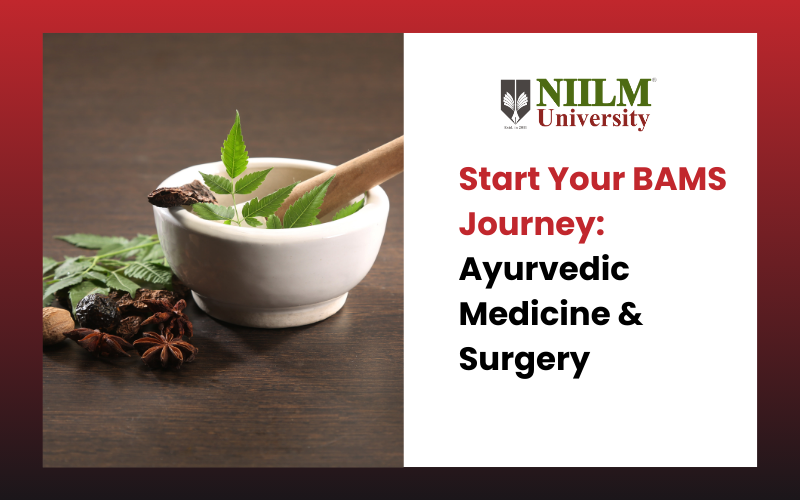Admission Enquiry

Start your BAMS adventure and become an expert in this age-old, all-encompassing healthcare system by learning Ayurvedic Medicine and Surgery.
If you're considering a career in Ayurvedic Medicine and Surgery (BAMS), you're on the path to joining a field that's been healing people for thousands of years. Ayurveda, the ancient system of medicine rooted in India, offers a holistic approach to health and well-being. With its growing popularity and acceptance worldwide, a BAMS degree can open doors to a rewarding career. Let's dive into what BAMS is all about and why it might be the perfect choice for you.
What is BAMS (Bachelor of Ayurvedic Medicine and Surgery)?
BAMS stands for Bachelor of Ayurvedic Medicine and Surgery.This undergraduate program focuses on the study of Ayurveda, an age-old medical practice with roots in India that dates back more than 3,000 years. Ayurvedic medicine uses natural treatments and lifestyle practices to promote a state of balance in the body, mind, and spirit. Ayurvedic therapy, including herbal remedies, food regimens, and yoga, is included in BAMS.
Why Choose BAMS?
Choosing BAMS means opting for a career that's in harmony with nature. Here are some strong arguments in favor of taking this route:
Increasing Demand for Ayurvedic Practitioners: Qualified Ayurvedic practitioners are in greater demand as interest in natural and holistic health solutions grows.
Holistic Healing Approach: In contrast to modern treatment, Ayurveda treats the patient as a whole, emphasizing the underlying causes of illnesses as opposed to their symptoms.
Integration with Modern Medicine: Ayurvedic practices are increasingly being integrated with modern medical treatments, providing a more comprehensive approach to health care.
Eligibility Criteria for BAMS
Educational Requirements: It is usually required that you have finished your upper secondary school in topics like biology, chemistry, and physics, which is the 12th grade.
Age Limit: Most institutions require candidates to be at least 17 years old at the time of admission.
Entrance Examinations: Admission often involves clearing entrance exams such as NEET (National Eligibility cum Entrance Test) in India.
Subjects in Bachelor of Ayurvedic Medicine and Surgery
Kriya Sharira (Physiology)
The goal of this subject is to comprehend human physiological processes from an Ayurvedic perspective. It addresses a variety of subjects from an Ayurvedic standpoint, including metabolism, digestion, and the roles of various organ systems.
Rachna Sharira (Anatomy)
The study of human anatomy, including the composition of the body's tissues and organs, is covered by Rachna Sharira. In accordance with Ayurvedic literature and contemporary science, it examines both gross and microscopic anatomy.
Dravya Guna (Pharmacology)
The study of drugs (dravyas) used in Ayurveda is covered in this subject. It covers the categorization, characteristics, and uses of minerals, plants, and other materials utilized in Ayurvedic medicine.
Panchakarma (Detoxification and Rejuvenation Therapies)
The study of drugs, or "dravyas," as they are known in Ayurveda is covered in this course. The classification, characteristics, and uses of many materials utilized in Ayurvedic remedies, such as minerals, herbs, and other substances, are covered.
Kayachikitsa (Internal Medicine)
This course covers the diagnosis and Ayurvedic treatment of internal disorders. It covers the investigation of different illnesses and how nutrition, way of life, and herbal remedies might be used to treat them.
Shalya Tantra (Surgical Techniques)
Advanced surgical methods and the treatment of surgical illnesses are the main topics of Shalya Tantra. It covers both the conventional Ayurvedic surgical methods and their contemporary adaptations.
Jara and Vriddhavyadha (Geriatrics)
The health issues that older people face are covered in this topic. It covers research on age-related illnesses as well as the application of Ayurveda in managing geriatric disorders and encouraging healthy aging.
Ophthalmology and ENT (Shalakya Tantra)
The Ayurvedic remedies for conditions of the eyes, ears, nose, and throat are covered in the Shalakya Tantra. It covers the diagnosis and treatment of diseases affecting these organs.
Career Opportunities After BAMS
Integrating Ayurveda with Modern Medicine
Case Studies: Numerous case studies highlight the successful integration of Ayurvedic treatments with conventional medical practices.
Successful Integrations: From managing chronic conditions to post-surgical recovery, Ayurveda complements modern treatments.
Future Prospects: The future looks promising with ongoing research and increasing acceptance of Ayurvedic practices in mainstream healthcare.
Conclusion
In conclusion, choosing to begin your career in Ayurvedic Medicine and Surgery (BAMS) can be a happy and satisfying decision. With a long history, a comprehensive philosophy, and increasing recognition, Ayurveda presents a distinctive route in the medical domain. An excellent foundation is provided by a BAMS degree, regardless of your career goals—clinical practice, research, or teaching. Accept the chance to use Ayurvedic expertise to heal and improve people's lives.
Frequently Asked Questions (FAQs)
Q1. Can I pursue research after BAMS?
A1. Yes, BAMS graduates can engage in research in Ayurvedic medicine and related fields by pursuing M.Phil. or Ph.D. programs.
Q2. Are there specialization options available after BAMS?
A2. Yes, BAMS graduates can pursue postgraduate courses (MD/MS in Ayurveda) in various specializations such as Panchakarma, Kayachikitsa, Dravyaguna, and Shalyatantra.
Q3. Can I practice Ayurveda outside India after completing BAMS?
A3. Yes, but you may need to comply with the regulatory requirements of the specific country where you intend to practice.
Q4.What are the benefits of studying BAMS?
A4. Studying BAMS offers a deep understanding of traditional Ayurvedic medicine, opportunities to contribute to holistic healthcare, and a rewarding career in a growing field.
Q5. Is an internship mandatory in the BAMS program?
A5. Yes, a one-year internship is a mandatory part of the BAMS program, providing practical experience in hospitals and clinics.
Copyrights © 2024 NIILM UNIVERSITY. All rights reserved.